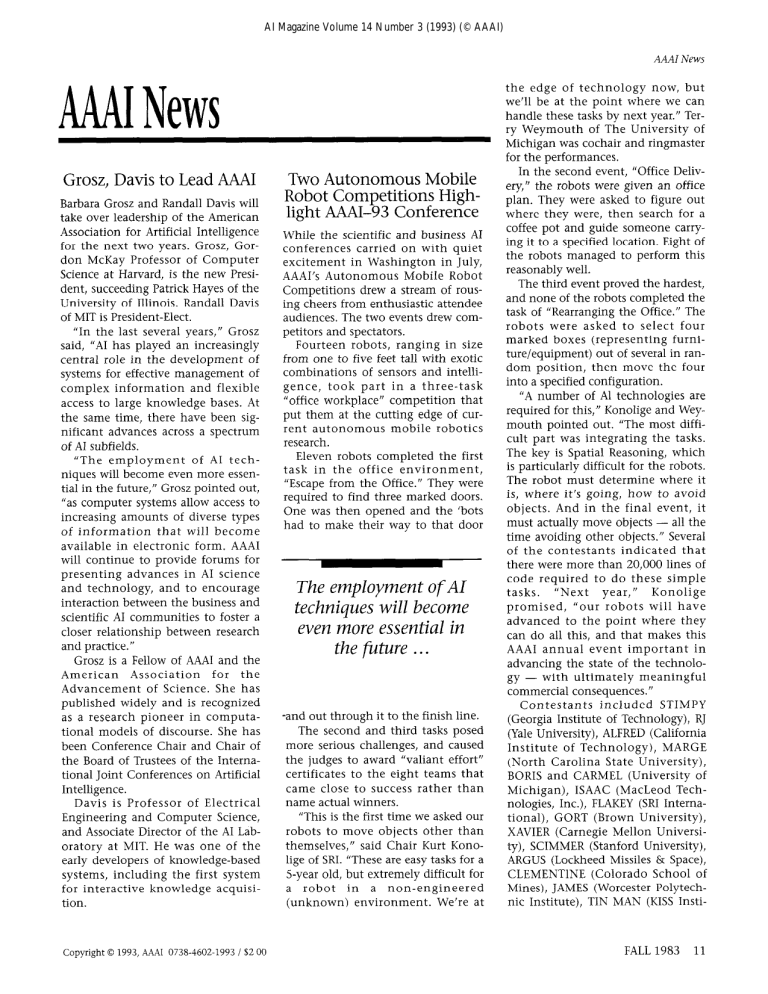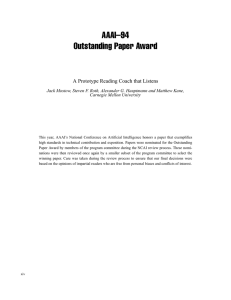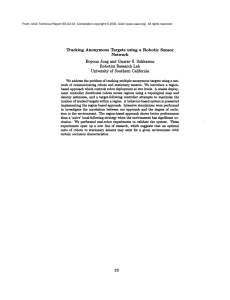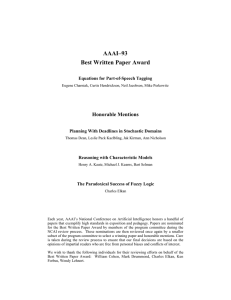AAAI News Grosz, Davis to Lead AAAI Two Autonomous Mobile
advertisement

AI Magazine Volume 14 Number 3 (1993) (© AAAI) AAAI News AAAI News Grosz, Davis to Lead AAAI Barbara Grosz and Randall Davis will take over leadership of the American Association for Artificial Intelligence for the next two years. Grosz, Gordon McKay Professor of Computer Science at Harvard, is the new President, succeeding Patrick Hayes of the University of Illinois. Randall Davis of MIT is President-Elect. “In the last several years,” Grosz said, “AI has played an increasingly central role in the development of systems for effective management of complex information and flexible access to large knowledge bases. At the same time, there have been significant advances across a spectrum of AI subfields. “The employment of AI techniques will become even more essential in the future,” Grosz pointed out, “as computer systems allow access to increasing amounts of diverse types of information that will become available in electronic form. AAAI will continue to provide forums for presenting advances in AI science and technology, and to encourage interaction between the business and scientific AI communities to foster a closer relationship between research and practice.” Grosz is a Fellow of AAAI and the American Association for the Advancement of Science. She has published widely and is recognized as a research pioneer in computational models of discourse. She has been Conference Chair and Chair of the Board of Trustees of the International Joint Conferences on Artificial Intelligence. Davis is Professor of Electrical Engineering and Computer Science, and Associate Director of the AI Laboratory at MIT. He was one of the early developers of knowledge-based systems, including the first system for interactive knowledge acquisition. Copyright 0 1993, AAAI 0738-4602-1993 / $2 00 Two Autonomous Mobile Robot Competitions Highlight AAAI-93 Conference While the scientific and business AI conferences carried on with quiet excitement in Washington in July, AAAI’s Autonomous Mobile Robot Competitions drew a stream of rousing cheers from enthusiastic attendee audiences. The two events drew competitors and spectators. Fourteen robots, ranging in size from one to five feet tall with exotic combinations of sensors and intelligence, took part in a three-task “office workplace” competition that put them at the cutting edge of current autonomous mobile robotics research. Eleven robots completed the first task in the office environment, “Escape from the Office.” They were required to find three marked doors. One was then opened and the ‘bots had to make their way to that door The employment of AI techniques will become even more essential in the /%ture . . . -and out through it to the finish line. The second and third tasks posed more serious challenges, and caused the judges to award “valiant effort” certificates to the eight teams that came close to success rather than name actual winners. “This is the first time we asked our robots to move objects other than themselves,” said Chair Kurt Konolige of SRI. “These are easy tasks for a 5-year old, but extremely difficult for a robot in a non-engineered (unknown) environment. We’re at the edge of technology now, but we’ll be at the point where we can handle these tasks by next year.” Terry Weymouth of The University of Michigan was cochair and ringmaster for the performances. In the second event, “Office Delivery,” the robots were given an office plan. They were asked to figure out where they were, then search for a coffee pot and guide someone carrying it to a specified location. Eight of the robots managed to perform this reasonably well. The third event proved the hardest, and none of the robots completed the task of “Rearranging the Office.” The robots were asked to select four marked boxes (representing furniture/equipment) out of several in random position, then move the four into a specified configuration. “A number of Al technologies are required for this,” Konolige and Weymouth pointed out. “The most difficult part was integrating the tasks. The key is Spatial Reasoning, which is particularly difficult for the robots. The robot must determine where it is, where it’s going, how to avoid objects. And in the final event, it must actually move objects - all the time avoiding other objects.” Several of the contestants indicated that there were more than 20,000 lines of code required to do these simple “Next year,” Konolige tasks. “our robots will have promised, advanced to the point where they can do all this, and that makes this AAAI annual event important in advancing the state of the technology - with ultimately meaningful commercial consequences.” Contestants included STIMPY (Georgia Institute of Technology), RJ (Yale University), ALFRED (California Institute of Technology), MARGE (North Carolina State University), BORIS and CARMEL (University of Michigan), ISAAC (MacLeod Technologies, Inc.), FLAKEY (SRI International), GORT (Brown University), XAVIER (Carnegie Mellon University), SCIMMER (Stanford University), ARGUS (Lockheed Missiles 2%Space), CLEMENTlNE (Colorado School of Mines), JAMES (Worcester Polytechnic Institute), TIN MAN (KISS Insti- FALL 1983 11 AAAI News tute) and VAGABOND (Stanford University). The second competition combined a robotics tutorial with actual construction of tabletop robots. Seventy participants on more than a score of teams entered, and worked feverishly for 72 hours to construct their Autonomous Mobile Robots from kits. The kits contained sensors, motors, microprocessor control board and LEGO. “Our goal was to give AI scientists and researchers ‘real world’ experience in dealing with robots. We wanted to help people conquer robot phobia . . . help people never before involved in robotics get over their fears, learn enough to feel confident about continuing in robotics,” said Lynn Andrea Stein of MIT and David Miller of Mitre, Chairs of the event. All the robots competed in matched play elimination contests which parodied the three events of the “big robot” competition. The first stage involved “finding the office,” the second “moving the coffee pot.” AT&T Bell Labs handily won the first event with its “Death Star 2000” creation. Mitre’s Houston Lab topped the second event with “Not Yet.” The robot names seemed to mirror the eclectic designs of their creators. AAAI Member Receives NSF Young Investigator’s Award Assistant Professor Oren Etzioni (University of Washington) received an NSF Young Investigator’s Award for his work in machine learning and software agents. AAAI congratulates Etzioni on this distinguished achievement. Thanks to Elaine Rich AAAI and AI Magazine wish to acknowledge, with thanks, the diligent efforts of Elaine Rich, who stepped down as coeditor of the AI Magazine, effective with this issue. Rich, who previously served on the AAAI Council, noted that she was stepping down from her position as editor in order to devote additional time to writing. 12 AI MAGAZINE Florida Subscription Tax Florida members please note: Because of a new Florida law, AAAI must, after July 1, 1993, collect 6% tax on the subscription amount ($12.50) of your membership. Please add this additional $.75 tax when renewing your membership. describing the contributions that are seen as meriting the award . A curriculum vitae of the nominee . Letters of support for the nomination documenting the breadth of the contributions or their interdisciplinary nature These should be sent no later than November 30, 1993 to either Allen Newell Award Call for Nominations The ACM Council has authorized the establishment of an award honoring the memory and achievements of Allen Newell Financial support for the Allen Newell Award is provided, in part, by the American Association for Artificial Intelligence. Newell (1927-1992) was a recognized pioneer in computer science research and education, and a founder of the fields of artificial intelligence and cognitive science. His awards and honors included the Harry Goode Award of the American Federation of Information Processing (1971), the A.M. Turing Award of ACM (1975), the Distinguished Scientific Contribution Award of the American Psychological Association (1985), the Research Excellence Award of the International Joint Conferences on Artificial Intelligence (1989), the Emanuel R. Priore Award of the Institute for Electrical and Electronic Engineers (1990), and the National Medal of Science (1992). He was elected to the National Academy of Science and the National Academy of Engineering. Newell was the author or coauthor of more than 250 publications, including 10 books. The Allen Newell Award will be presented to an individual selected for career contributions that have breadth within computer science, or that bridge computer science and other disciplines. Starting in 1993, the award will be given biennially, but it is intended that, eventually, it will be given annually. The award will consist of a cash prize of $10,000 and a plaque. Nominations are invited for the 1993 Award. Submissions should include A letter from the nominator(s) l Edward A. Feigenbaum Chairman ACM Newell Award Committee Dept. of Computer Science Stanford University 701 Welch Road, Building C Palo Alto, CA 94304 or ACM Newell Award Committee Association for Computing Machinery 15 15 Broadway New York, NY 10036-9998 The presentation for the 1993 Award will take place in conjunction with the Computer Science Conference, Phoenix, Arizona, March S-10, 1994. AAAI Welcomes New Councilors AAAI welcomes and congratulates Ramesh Patil, Peter Friedland, Robert Engelmore, and Thomas Dean, who have been elected to serve on the AAAI Executive Council from 1993-1996. New Dues for Subgroups At the July Executive Council meeting, AAAl’s board voted to establish additional dues of $10.00 per year per group for membership in each AAAI subgroup. Although this step was taken reluctantly, the council noted that the nominal fee was necessary to help defray the costs of mailing and producing the subgroup newletters. When renewing their membership, AAAI members should therefore add $10 00 for each subgroup that they wish to join.





